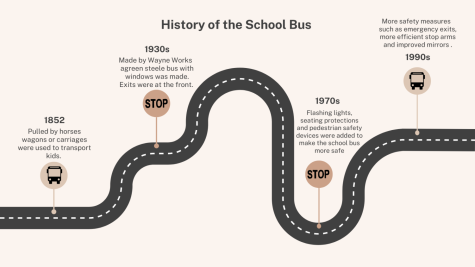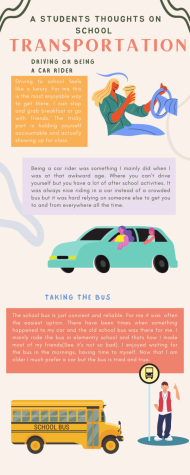
Photo Credit: Art By Jasmine Bezotte
The Yellow Cheese Wagon Provides Reliable Transportation
October 17, 2022
The school bus has gone through many changes since its creation, from its design to the people who ride it. School buses offer different experiences for the driver, the rider, and even the teachers. Throughout the years, school buses have unlocked a special part of our memories that constantly remind us why they are so important.
The History Of The School Bus

The history of the school bus is extensive. Quite frankly it is a long journey. The school bus that is seen today has not always been so big, sturdy and robust. I actually did not know students took a bus (or bus variant) to school as far back as 1852.
The recent edition of the Smithsonian Magazine profiled the history of the school bus, giving me a much more thorough understanding of how the bus we know today came to fruition. It was interesting that the bus started out as a horse drawn carriage. Compare that to the bus in the present day and the differences are obvious, making the two things seem almost entirely different.
When the first version of the bus was made, they were used predominantly by white children. When they were made more local and used there was still segregation and most black kids, if not all of them, did not ride the bus. The magazine also touches on the desegregation of school buses after Brown v. Board. Because segregated public schools were deemed unconstitutional, school buses became a major spot of integration for students and became a spot for diversity and inclusion. This is good in my eyes. The only thing that bothers me is that it did not happen sooner.
The bus back then seemed uncomfortable and inconvenient. I feel as if the horse drawn carriage bus was in the right place, as children deserve a safe way to school but in the end ultimately was less useful than, say, walking. The joltyness and bumpiness of the wagon could cause nausea.
I genuinely think that the creators of the horse wagon school buses should have realized that the seats and build of the wagon needed to be made suitable for children. The idea was good but the way they acted on it was probably out of a thought for profit and not out of a want to provide for the children in the best way possible.
The bus that is seen and known today is derived from the 1939 design and has remained much the same since then. That is why buses captured in pictures look like they have had the same design since 1939. I found that interesting. I had always wondered how long the bus had its current design.
Interestingly enough the color of the bus is unique and is a uniquely made color for school buses. The name of the color was dubbed “National School Bus Glossy Yellow” but is technically called “Color 13432”.
I think the history of the school bus is so deep and complex with tons of rich history. Something that started out as a horse drawn carriage turned into a yellow automotive machine that can hold dozens of children and provide a safe way to and from school.

Photo Credit: Tess Warren
Veteran Bus Driver Shares Her Dedication To Her Job
The bus may deliver students to and from school, but the bus driver makes the ride what it is. Driver Kat McFarland exemplifies all of the amazing qualities of a great bus driver as she continuously impacts lives.
McFarland began driving the bus over 21 years ago. She decided to become a bus driver so she could have a job that would allow her to balance being a full-time mom, as well as give her something exciting and interesting to do.
“I got the chance to be a full-time momma to my kids, which was a huge priority for me,” McFarland said. “It’s fun. I love my job. I like driving and I really like seeing the kids happy and watching them have fun.”
McFarland shows this passion for her job and her students by how she goes above and beyond just driving her daily routes. She drives the bus for many field trips including every photography club field trip.
“I met Kat in the mid-2000s. I think around 2008,” photography teacher Eric Mittman said. “She’s the only driver I use now. We’ve gone on so many trips together. We’ve been everywhere within a 100-mile radius of Harvest. We’ve been to mountains, canyons, big cities, small cities, museums, fairs, festivals, zoos, aquariums, photo studios, racetracks, airports, and it just goes on and on. These trips couldn’t happen without her. She’s willing to take our kids on trips that last from 5:30 in the morning to 10 at night. And we go to 5 or 6 locations each trip. She’ll go anywhere and everywhere, she is genuinely the best travel partner.”
While not a requirement of the job, McFarland chooses to drive for these field trips so students go places where they can have meaningful experiences that they could not have otherwise. By driving for field trips she opens countless doors, and helps students create countless memories. She believes in the importance of students being able to have these chances.
“I get to go on lots of field trips, and see lots of super cool places,” McFarland said. “I’ve gotten to go on a lot of photo field trips. They go to a lot of amazing places. My favorite part of the trips is when they get back on and have super excited faces. It’s so cool watching them.”
McFarland uses her drives, both on field trips and regular school days, as an opportunity to be a light in the days of those around her. Students and faculty look forward to her driving them due to her joyful nature and genuinely kind soul.
“When Kat drives, we always have great adventures,” Mittman said. “Outgoing, down-to-earth, willing to help out in any way at any time. She has the best sense of humor and an amazing rapport with the kids. Look up ‘genuine, good, decent, helpful person in the dictionary and you’ll find her picture.”
“I had her as a field trip driver,” senior Alyssa Miller said. “She was so sweet. She was really flexible, letting us make an impromptu stop. You could tell she genuinely wanted to be there and actually cared about us. Without her, we couldn’t have taken our trip and seen some of the coolest sights.”
McFarland takes her job seriously, knowing the importance of delivering her students in a safe and timely manner. McFarland is excellent at getting her students to their destination in a timely manner, as well as safely. She makes sure to ensure that her bus is a safe environment both physically and emotionally.
“I have the expectations of common respect and common knowledge,” McFarland said. “I expect my students to sit down and behave, so I can focus as well as make other kids feel comfortable. I believe that everyone should use common decency and good behavior, so everyone can have a pleasant ride.”
McFarland continues to dedicate herself to helping students, even in difficult times such as the pandemic or teacher shortage. She chooses to focus on the many positive moments and the necessity of her job instead.
“People are tough sometimes. Parents and students both,” McFarland said. “One time I even got cussed at by a kindergartener. But to me it is fun. It’s what you make of it. You can make it bad or you can make it good.”
McFarland goes above the obligations of her job, which allows her to get more enjoyment out of them. She chooses to make her rides fun for herself and her students.
“Any job can be good or bad, it’s what you put into it. I love my job. I wouldn’t be here otherwise,” McFarland said. “I’m truly thankful for what it has allowed me to do.”
Photo Credit: Art By Olivia Lake
Teachers Shares Their Experience With Driving Buses
Because of the drastic drop in school staff after the pandemic, an opportunity arose for teachers to support the school and earn a little more support for themselves while they are at it. This past year, health education teacher Cedric Austin and math teacher Josh Moore took the chance to become bus drivers.
“Becoming a bus driver was a great opportunity to increase my salary and alleviate the bus driver shortage at our school,” Austin said. “Bus drivers willing to cover additional routes are financially compensated. The shortages have increased class sizes and the number of students per bus.”
Moore understands the strain schools all around are going through to remain functional at the least. While it has yet to get that desperate, Moore feels the added pressure to always be present so he can be dependable as a teacher and a bus driver.
“I feel like I can’t take a day off because it would require someone else to cover for me, which typically means someone will have to do extra work because I took off,” Moore said. “If I have to miss a day of work, then I have to find a sub for my teaching position and my bus position.”
This is Moore’s first year as a full-time bus driver. He had his bus license when he lived in Louisiana and drove the teams that he coached. He opted to help out since his schedule opened up and the additional income would help pay for his kids’ college expenses.
“I became a bus driver because I needed the extra money and I always enjoyed driving a bus,” Moore said. “I think driving a bus is a great way for teachers to earn some extra money, especially for teachers who don’t have little kids. My youngest went off to college this fall so I had some extra time on my hands and I knew that we needed more bus drivers.”
Moore enjoys the pay without sacrificing his days off. Since bus drivers have the same schedules as teachers, he still gets weekends and school breaks off. However, a day’s work now includes waking up at 4:30 a.m. and heading home around 6 p.m.
“I’ll be honest, I don’t get as much sleep as I’d like anymore. I usually come home exhausted,” Moore said. “Since I also drive an afternoon route, I sometimes have to stay at the school until 6 p.m. in order to get ready for the next day or to grade tests. I arrive at the school around 6 a.m. to drop my stuff off in my classroom and then start my route at 6:30 a.m. This all requires me to get up at 4:30 a.m. to ensure that I start my route on time. I pride myself on being on time every morning.”
There is definitely more to bus delays than lazy bus drivers. The biggest delay occurs when a driver is out and an elementary driver has to pick up the route. They must finish their elementary route first and then start the high school route. This can cause the high schools to be 45 minutes to an hour late. Traffic always plays a part and there is always the chance of a bus breaking down.
“As a bus driver, it’s my responsibility to ensure each student arrives at and from school safely each day,” Austin said. “Some of our responsibilities to ensure that include: a daily pre and post-trip bus inspection, a morning and afternoon student headcount, refueling the bus at half a tank and maintaining a clean bus.”
Bus drivers are required to have a commercial driver’s license (CDL) with a passenger and school bus endorsement. They must also pass a written test and road test administered by the Alabama State Department of Transportation.
“To drive, you have to get accustomed to the size and length of driving a 40-foot bus as opposed to an 8-foot car. Some of the differences include the size of the bus, air brakes, speed limit restriction and additional mirrors and switches,” Austin said. “A bus uses air brakes which require pressure to build up before the bus is safe to drive. The speed limit for driving a bus is 5 mph slower than the posted speed limit. Another difference is periodically checking seven mirrors instead of just two and operating bus control switches during each route.”
As official bus drivers, teachers can drive for field trips, sports and band activities. A couple of times this season, Moore drove the color guard to football games. Sometimes he drives an elementary sub route to be at school on time since they start earlier. Moore dislikes missing any instructional time with his class. He genuinely enjoys driving and even likes driving larger vehicles.
“I have had a dream of one day owning a motorhome and traveling all over the country on my breaks,” Moore said. “However, an expensive dream and a school teacher salary don’t always make the best combination, so driving a bus may be as close as I get to driving something that big. I like being able to help out and I’ve really enjoyed driving the bus so far. I hope that I can continue doing this for many years to come.”
Austin hopes for an eventual full staff of bus drivers, in the meantime, he believes the board will need to come up with additional incentives if the shortage of drivers continues. Otherwise, the pressure will burn out the current bus drivers, prompting them to leave and snowballing the problem.
“I would absolutely encourage other teachers to become bus drivers. It’s a great opportunity to help our local community outside of the classroom and be financially compensated,” Austin said. “Hopefully, the students will have greater respect for teachers who are willing to make the necessary sacrifices to take them to and from school safely; as well as provide them with the best education possible.”
Students Share Their Thoughts On School Transportation


